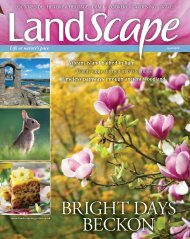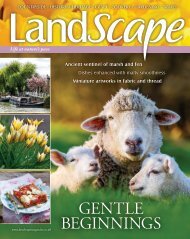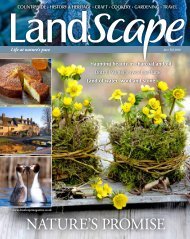You also want an ePaper? Increase the reach of your titles
YUMPU automatically turns print PDFs into web optimized ePapers that Google loves.
STILL ONLY £1.99! PLUS 2 x FREE SEEDS<br />
<strong>May</strong> 27, 2017<br />
£4.58!<br />
worth<br />
2 x FREE<br />
SEEDS!<br />
£4.58<br />
worth<br />
Britain's<br />
most trusted<br />
voice in<br />
gardening<br />
Carol Klein<br />
'Try my favourite<br />
shade-lovers!'<br />
Ornamental<br />
grasses can<br />
be pot stars!<br />
Cornflowers<br />
for vibrant<br />
spring colour<br />
5<br />
WHY WE NEED<br />
MORE MOTHS!<br />
Low growers<br />
to tolerate<br />
drought<br />
Enjoy a brilliant<br />
Bank<br />
Holiday!<br />
● Best garden centre buys right now<br />
● How to do the Chelsea Chop<br />
● Find the right plants for your soil<br />
FREE!<br />
SEEDS, BULBS & PLANTS<br />
WORTH OVER £46<br />
JUST PAY P&P
what to doThis<br />
Meet<br />
the<br />
team<br />
If you do<br />
Ian Hodgson<br />
Kew-trained horticulturist and<br />
garden designer. Previously<br />
with the RHS, Ian is interested<br />
in all aspects of gardening.<br />
just one job...<br />
Get those<br />
perfect pots<br />
Here’s how to plant up great<br />
containers for a summer show<br />
Karen Murphy<br />
A keen container<br />
gardener, Karen has<br />
RHS qualifications<br />
and also loves wildlife.<br />
Week<br />
Plus<br />
● Inspirational gardener Nick Bailey<br />
● Undercover gardener Martin Fish<br />
● Growing for showing with Medwyn Williams<br />
● Tales from the allotment with Terry Walton<br />
Create bold<br />
impact<br />
with neon<br />
colours!<br />
Now’s the time to get our pots ready to give us a<br />
big splash of colour on our patios. As you’ll have<br />
read on page 14, there are some wonderful plant<br />
combinations that can provide lots of different themes,<br />
but you need to take time and care to get them just right!<br />
There are endless plants to go for now, so opt for an<br />
extra large container that’ll hold four or five. That way<br />
you can get more height, permanence and impact.<br />
If you’re planning to create a more permanent<br />
feature of your pot with foliage plants into autumn and<br />
winter, when the bedding goes over, use a plastic pot or<br />
fibreglass. Next, consider your compost. Use a multipurpose<br />
compost with added four-month fertiliser or<br />
standard multi-purpose with some slow-release fertiliser.<br />
Mix it with Perlite for an airy, well-draining mix. If you’ve<br />
more permanent plants, use a John Innes No 2 or No<br />
3 compost, which will be more nutritious for longer.<br />
Pop it in a sunny spot, water well and deadhead<br />
continually to make your display last the longest it can.<br />
l Turn back to page 14 for brilliant pot combinations.<br />
<strong>Garden</strong> <strong>News</strong><br />
RECOMMENDS<br />
Four plants for our pot<br />
Neil Hepworth<br />
Senetti ‘Deep Blue’<br />
Neon purple-blue daisy blooms<br />
stand tall above pretty, heartshaped<br />
leaves. Water well<br />
and deadhead.<br />
Shutterstock<br />
Osteospermum<br />
The variety used is ‘Margarita<br />
Yellow’, but try an array of<br />
these pretty African daisies.<br />
Likes a sunny spot.<br />
Shutterstock<br />
Impatiens<br />
Large, neon pink blooms above<br />
dark or light green, waxy<br />
foliage. Classic bedding that<br />
can flower until mid-autumn.<br />
Shutterstock<br />
Greenery<br />
Zingy lime cupressus<br />
‘Goldcrest’ is a potted staple,<br />
as well as easy-going foliage<br />
favourite variegated ivy.<br />
Shutterstock<br />
Subscribe for just £1 an issue. Go to www.greatmagazines.co.uk/gn<br />
June 3 2017 / <strong>Garden</strong> <strong>News</strong> 33
Alamy<br />
Britain’s most trusted<br />
voice in gardening<br />
SUBSCRIBE TODAY<br />
& GET EACH ISSUE FOR<br />
JUST £1<br />
P.14<br />
Petunia ‘Night Sky’ is<br />
in garden centres now<br />
Work, rest<br />
and play!<br />
It’s incredible to think the final<br />
Bank Holiday of spring is upon us<br />
already – where is the year going? I<br />
don’t know about you, but I’ve still<br />
got plenty of things I’d like to get<br />
stuck into this weekend and, like<br />
thousands of gardeners around the<br />
country, I’ll be heading to the garden<br />
centre! Check out the feature on page<br />
14 to see our advice on what’s best to<br />
buy right now – I shall certainly be<br />
heeding it! Thankfully our garden<br />
had plenty of long-overdue rain last<br />
week so I don’t feel too guilty hoping<br />
for a sunny weekend that involves<br />
work, rest and play outside.<br />
After all, gardens should<br />
be places of relaxation,<br />
too! Here’s to a happy<br />
few days gardening.<br />
<strong>Garden</strong> <strong>News</strong><br />
Editor<br />
P.36<br />
It’s easy to<br />
propagate your<br />
succulents<br />
Our cover star:<br />
Carol Klein<br />
P.20<br />
Spectacular views<br />
at our <strong>Garden</strong> of<br />
the Week<br />
P.35<br />
Add an herbaceous<br />
clematis to your border<br />
Some gardeners find shade a problem,<br />
but not Carol! Shady places can offer<br />
marvellous opportunities to grow some<br />
of the most beguiling plants. Find out<br />
more on page 30.<br />
Neil Hepworth<br />
Neil Hepworth<br />
Neil Hepworth<br />
Jonathan Buckley<br />
Go to p.34 for full details!<br />
Look inside!<br />
About Now<br />
4 <strong>News</strong> from the gardening world<br />
5 Plant of the Week:<br />
Centaurea montana<br />
7 My Life in Plants<br />
8 The best new plants<br />
on show at Chelsea<br />
10 Top 5... drought-loving<br />
low growers<br />
P.5<br />
12 Wildlife<br />
Features<br />
14 Find out why now is the best<br />
time to visit the garden centre<br />
18 Give your plot the Chelsea Chop<br />
20 <strong>Garden</strong> of the Week<br />
26 The best plants to suit your soil<br />
30 Carol Klein explains why shade<br />
lovers are so entrancing<br />
57 Home-grown: Parsley<br />
66 Secrets of a Head <strong>Garden</strong>er<br />
What To Do This Week<br />
35 Plant an herbaceous clematis<br />
36 Propagate succulents<br />
39 Rob Smith gets creative<br />
with corn<br />
41 Pot up a fig for more fruit, says<br />
Martin Fish<br />
42 Damp down the greenhouse<br />
43 Medwyn Williams grows the<br />
best peas for showing<br />
45 The allotment is greening up for<br />
Terry Walton<br />
The Experts<br />
46 Give ornamental grasses<br />
a good home!<br />
47 It’s time to plant out dahlias<br />
49 Tony Dickerson problem solves<br />
You and Your <strong>Garden</strong>s<br />
52 Readers’ gardens<br />
55 Your letters and photos<br />
Offers & Competitions<br />
59 Prize-winning crossword<br />
60 Six free tomato ‘Sweet Aperitif’<br />
63 Free agapanthus and anemone<br />
Get in touch!<br />
Email gn.letters@bauermedia.co.uk<br />
Facebook facebook.com/<br />
<strong>Garden</strong><strong>News</strong>Official<br />
Twitter twitter.com/<strong>Garden</strong><strong>News</strong>Mag<br />
Write to Simon Caney, <strong>Garden</strong> <strong>News</strong>,<br />
Media House, Peterborough Business<br />
Park, Lynch Wood, Peterborough PE2 6EA<br />
<strong>May</strong> 27 2017 / <strong>Garden</strong> <strong>News</strong> 3
AboutNOW<br />
New plants at<br />
CHELSEA 2017<br />
We showcase all the very best varieties being launched and<br />
exhibited at this week’s premier show<br />
Alpines<br />
Edelweiss<br />
‘Blossom of Snow’<br />
Long-stems reach 40cm<br />
(14in). Flowering spring<br />
and autumn. Ideal cut<br />
flower or border plant.<br />
Well-drained soil in sun.<br />
From: www.suttons.co.uk,<br />
tel: 0844 326 2200.<br />
Climbers<br />
Thorncroft<br />
Fruit and veg<br />
Darcy & Everest<br />
Lewisia ‘Little<br />
Snowberry’<br />
Evergreen rosettes<br />
of succulent foliage.<br />
Blossoms from late<br />
spring. Any welldrained<br />
soil in full sun<br />
or pots. From: www.<br />
darcyeverest.co.uk,<br />
tel: 01480 497672.<br />
Suttons<br />
Mulberry<br />
‘Charlotte Russe’<br />
Breakthrough mulberry<br />
to 1.5m (5ft). Selfpollinating,<br />
producing<br />
fruit on old and new<br />
wood over long season.<br />
From: www.suttons.<br />
co.uk, tel: 0844 326 2200.<br />
Clematis ‘Taiga’<br />
Exotic flowers change shape<br />
with age. Sheltered position<br />
on a wall, fence or pots. From:<br />
www.thorncroftclematis.<br />
co.uk, tel: 01953 850407.<br />
Clematis ‘Green Passion’<br />
Unusual variety with double green,<br />
white-tipped flowers over a long<br />
season. Semi-shade in borders or<br />
pots. From: Thorncroft Clematis<br />
(see details, left).<br />
Thorncroft<br />
Cucumber ‘Merlin’<br />
Productive, all-female<br />
variety with 15cm (6in) fruit.<br />
Mildew resistant. Best indoors.<br />
From: www.pennardplants.com,<br />
tel: 01749 860039.<br />
Pennard Plants<br />
Suttons<br />
Sweet pepper ‘Popti’<br />
Compact sweet bell pepper. Ideal<br />
for pots indoors and out. Early<br />
ripening and virus resistant.<br />
From: www.pennardplants.com,<br />
tel: 01749 860039.<br />
Pennard Plants<br />
8 <strong>Garden</strong> <strong>News</strong> / <strong>May</strong> 27 2017
Greenhouse<br />
Fuchsia ‘Sarcoma UK’<br />
New upright, long-flowering,<br />
bush fuchsia. All proceeds from<br />
sales to charity Sarcoma UK.<br />
From: www.roualeynfuchsias.<br />
co.uk, tel: 01492 640584.<br />
Fibrex<br />
Pelargonium<br />
‘Rushmore Amazon’<br />
Breakthrough ‘Zonartic’ pelargonium<br />
with 5cm (2in) yellow blossoms. From:<br />
www.fibrex.co.uk, tel: 01789 720788.<br />
Ian Strawson<br />
Perennials<br />
Trees and Shrubs<br />
Salvia ‘Crystal Blue’<br />
Pastel blue sage forms a compact mound of summer blossom to<br />
50cm (20in). From: www.hardys-plants.co.uk, tel: 01256 896533.<br />
Hardy’s Cottage <strong>Garden</strong> Plants<br />
Rosa ‘James L. Austin’<br />
Fruitily-fragrant blossoms possess<br />
old rose elegance. Long flowering,<br />
neat and disease resistant. From<br />
www.davidaustinroses.co.uk,<br />
tel: 01902 376300.<br />
David Austin<br />
Heuchera<br />
‘Sweet Caroline’<br />
Neat, evergreen, lemon and<br />
lime foliage with pink flowers.<br />
From: www.plantagogo.com,<br />
tel: 01270 820335.<br />
Plantagogo<br />
Iris ‘Rachel<br />
de Thame’<br />
Distinctive colour combination<br />
named after the TV presenter.<br />
From: www.iris-cayeux.com,<br />
tel: freephone 0800 096 4811.<br />
Cayeux<br />
Corydalis<br />
‘Porcelain<br />
Blue’<br />
Spring and autumnflowering<br />
perennial.<br />
Moist, well-drained<br />
soil. From: www.<br />
hillier.co.uk, tel:<br />
01794 368733.<br />
Subscribe for just £1 an issue. Go to www.greatmagazines.co.uk/gn<br />
Hillier<br />
Malus ‘Crimson<br />
Cascade’<br />
Weeping crab apple suitable<br />
for borders or lawn specimens.<br />
Purple foliage in spring. Red<br />
fruits in autumn. From: www.<br />
hillier.co.uk, tel: 01794 368733.<br />
Hillier<br />
Betula pendula<br />
‘Fastigiata Joes’<br />
Pencil-like, upright form of<br />
common birch. Ideal for narrow<br />
spaces and deciduous hedges.<br />
From: www.frankpmatthews.<br />
com, tel: 01584 810214.<br />
<strong>May</strong> 27 2017 / <strong>Garden</strong> <strong>News</strong> 9<br />
Frank P Matthews
The best plants to<br />
suit your soil<br />
Don’t fight what’s on your plot! Instead<br />
pick plants that’ll feel right at home there<br />
Asters are just<br />
one of the plants<br />
that’ll appreciate<br />
rich clay soil<br />
Words Naomi Slade<br />
This is the moment the garden gets<br />
into its stride. The risk of frost<br />
has passed and soil is warming<br />
nicely, so it’s time for us to leap into<br />
action! To get the best from your plants,<br />
it helps to know what soil type you<br />
have. While some are easy and biddable,<br />
others love sharp drainage, hanker<br />
for moisture or are picky about pH.<br />
Most soils are a mix of various<br />
elements such as sand, clay, chalk<br />
and organic matter, often with one<br />
type predominating; and sun and<br />
shade, acidity and alkalinity also play<br />
a role. But a great garden begins with<br />
its soil, so before you hit the shops<br />
or the internet for a glorious splurge<br />
of colour, take a moment to put your<br />
nose to the ground and make sure that<br />
every plant you pick will be a winner!<br />
COPING WITH CLAY<br />
Clay soils are both a blessing and a curse.<br />
They hold nutrients and water well but take a<br />
long time to warm up in spring, can bake dry<br />
in summer and can be back-breaking to work!<br />
But there are lots of plants that are happy<br />
on clay, taking the rough with the smooth and<br />
enjoying the rich living when it comes. It’s a<br />
long list – alchemilla, asters, and astrantia<br />
should do well, and so on down the alphabet.<br />
But for a real eye-catcher, plant sweet gum,<br />
Liquidambar styraciflua. With palmate<br />
leaves and unrivalled autumn colour, it’s<br />
a joy to behold! And for a hardworking<br />
shrub in a prominent spot, it’s hard to beat<br />
Viburnum bodnantense ‘Dawn’. In winter,<br />
it throws out masses of pink, scented flowers<br />
that add life to a border, following up with<br />
summer berries and bright autumn foliage.<br />
Clay soil is sticky and<br />
moulds into a ball<br />
Bauer<br />
Bauer<br />
CHOOSING FOR CHALK<br />
Chalky soils are common<br />
in the UK, ranging from<br />
heavy alkaline clays to the<br />
incredibly light and friable<br />
soils in parts of Kent and the<br />
Sussex Downs, the latter<br />
of which are free-draining,<br />
prone to drought and are<br />
often short of nutrients.<br />
Fortunately, clematis love<br />
alkaline soils. If your local<br />
hedges are covered with old<br />
man’s beard, take the hint<br />
and go crazy for climbers!<br />
Just make sure the roots<br />
are shaded and that you<br />
incorporate lots of organic<br />
matter when planting.<br />
The spindle tree<br />
(Euonymus europaeas)<br />
likes lime and can be<br />
underplanted with bulbs or<br />
pretty campanulas. Grasses<br />
like sunny, well-drained<br />
conditions – try beefy Stipa<br />
gigantea, or miscanthus<br />
and Festuca glauca varieties.<br />
Chalky soils can be<br />
shallow and stony<br />
Spindle is a fan of<br />
chalk and looks<br />
beautiful in autumn<br />
GAP<br />
Alamy<br />
Clematis grow really well<br />
in chalky, alkaline soils<br />
26 <strong>Garden</strong> <strong>News</strong> / <strong>May</strong> 27 2017
PLACING IN PEAT<br />
Heathers naturally<br />
do well in peat<br />
Alamy<br />
Lupins like<br />
poor soil but<br />
dislike chalk<br />
GAP<br />
Alamy<br />
Ferns enjoy the<br />
water retention<br />
of peaty soil<br />
Peaty soils are high<br />
in organic matter<br />
GAP<br />
Peat is partially decomposed<br />
moss, built up over a long<br />
period of time. It’s fibrous,<br />
high in organic matter and<br />
retains water well, although<br />
it tends to be acidic. Peat’s<br />
naturally found in bogs,<br />
often in upland areas and<br />
in the north and west, and<br />
it’s a relatively uncommon<br />
garden soil type.<br />
The best plants for peat are<br />
those that thrive with lots of<br />
juicy organic matter. Ferns<br />
will throw out a symphony of<br />
frolicsome fronds and other<br />
woodlanders will also excel.<br />
On a sunny site, heathers<br />
like peaty uplands and thrive<br />
in the garden. Meanwhile,<br />
the low pH means other<br />
ericaceous plants, such as<br />
camellias and azaleas, will<br />
thrive with spectacular style.<br />
SITING IN SAND<br />
Alamy<br />
Sandy soils are superlight<br />
and free draining,<br />
but they’re usually poor.<br />
The trick is to use plants<br />
that have adapted to hot<br />
or exposed areas and<br />
thrive with a minimum<br />
of watering or feeding.<br />
These often have silvery<br />
or fleshy leaves and<br />
many Mediterranean<br />
herbs and seaside-type<br />
plants will do well.<br />
Lavender is a classic,<br />
with its elegant pink or<br />
purple flowers borne<br />
over ever-grey foliage.<br />
Or try rosemary,<br />
thyme, santolina or<br />
sage. If it can survive<br />
a sea-cliff, then thrift,<br />
Armeria maritima,<br />
will be a breeze in a<br />
sandy garden! With<br />
neat, evergreen<br />
clumps topped with<br />
perky, pink flowers<br />
over a long season, it’s<br />
undemanding and<br />
perennially pretty.<br />
Silvery-leaved santolina<br />
has adapted to thrive with<br />
minimum water<br />
Seaside plant<br />
thrift should<br />
have no problem<br />
coping with sand!<br />
Sandy soils are<br />
light, warm and dry<br />
Bauer<br />
Subscribe for just £1 an issue. Go to www.greatmagazines.co.uk/gn<br />
Continues over the page<br />
<strong>May</strong> 27 2017 / <strong>Garden</strong> <strong>News</strong> 27<br />
Alamy
CAROL KLEIN<br />
This week<br />
AT GLEBE<br />
COTTAGE<br />
‘Top of the list are<br />
the epimediums.<br />
It’s difficult to<br />
understand why<br />
this is such an<br />
underused family’<br />
Revel in<br />
the shade<br />
It offers a marvellous opportunity to grow some<br />
of the most entrancing plants on the planet!<br />
Epimedium<br />
versicolor<br />
‘Sulphureum’<br />
Shade is often seen as<br />
a major problem, and one<br />
shared by most gardeners.<br />
It may be cast by man-made<br />
objects – buildings, walls or<br />
fences, or by plants – hedges,<br />
trees and shrubs. In urban<br />
gardens it’s often a combination<br />
of both – shade from house walls,<br />
compounded by that cast by<br />
trees. At ground level this may<br />
result in large, shadowy areas<br />
with dry, impoverished soil,<br />
reason enough for most of us<br />
to wring our hands and gnash<br />
our teeth. But before anyone<br />
throws in the horticultural<br />
trowel, it’s worth looking at<br />
how Mother Nature deals with<br />
similar circumstances.<br />
There are numerous plants<br />
throughout the temperate world<br />
that have evolved, along with the<br />
trees, not only to cope with dry<br />
shade but also to revel in it.<br />
Top of the list are the<br />
epimediums. It’s difficult to<br />
understand why this should be<br />
such an underused family, since<br />
all are perfectly amenable to<br />
shade and most are impervious<br />
to dry conditions.<br />
As winter progresses, the<br />
leaves of hybrids, such as<br />
Epimedium rubrum and<br />
Epimedium versicolor, becomes<br />
burnished and more and more<br />
highly polished. In early spring<br />
I have to steel myself to cut the<br />
stems down to ground level.<br />
30 <strong>Garden</strong> <strong>News</strong> / <strong>May</strong> 27 2017
Photos: Jonathan Buckley, unless stated<br />
They’re still beautiful but if<br />
they’re left alone, the new<br />
flowers that are already formed<br />
at their bases will have to fight<br />
their way through and nail<br />
scissors and large amounts of<br />
patience will be needed to<br />
extract the old leaves.<br />
Flowers in April are swiftly<br />
followed by new foliage and<br />
the new leaves of epimediums<br />
are a delight, so thin as to be<br />
almost translucent with all<br />
the tenderness and freshness<br />
associated with the spring.<br />
The flowers are exquisite,<br />
many to a stem. Some, especially<br />
the Asiatic species, have long<br />
spurs, which gives them a sci-fi<br />
look. They’re the grounddwelling<br />
members of the<br />
mahonia and berberis family.<br />
Mahonia aquifolium is one of<br />
the best taller ground-covering<br />
plants for really dry shade,<br />
pukka throughout the year with<br />
lustrous, purple-tinted foliage in<br />
the winter, spikes of cheery<br />
yellow flowers, scented like<br />
lily-of-the-valley and followed by<br />
dark berries with a blue bloom<br />
which taste like blackcurrants!<br />
Another bomb-proof subject<br />
for dry shade is the periwinkle,<br />
vinca. V. major is big and buxom,<br />
while V. minor slightly more<br />
sedate. Both will extend stems,<br />
taking root as they go and<br />
clothing the ground, and neither<br />
The predominant colour in the<br />
garden at the moment is green,<br />
and nowhere is that more the<br />
case than in the lower part of the<br />
garden, where raised beds full<br />
of perennials lead down to our<br />
gipsy caravan. There have been<br />
snowdrops and daffodils and<br />
some early peonies – they’ve<br />
all disappeared now and apart<br />
from sweet rocket beginning to<br />
flower, it’s a green scene.<br />
There’s one exception that’s<br />
needs help. In the early part of<br />
the year through until April their<br />
dense stems are spangled with<br />
soft blue flowers. Close to Glebe<br />
Cottage, a north-facing bank,<br />
5m (16ft 6in) high and 10m<br />
(33ft) across, is smothered in<br />
its luxuriant growth. These<br />
evergreen, ground-covering<br />
plants can be relied on to put<br />
on a good show all year – even<br />
in the most inauspicious<br />
circumstances. Almost totally<br />
self-reliant, they’re a dream<br />
come true for city gardeners<br />
with little time on their hands.<br />
At the other end of the<br />
summer, leaves begin to thin<br />
out and another range of<br />
woodlanders exploit additional<br />
daylight. Many of these plants<br />
cope brilliantly with the sort of<br />
shade cast by buildings. One of<br />
the best examples are the group<br />
of Asiatic anemones, usually<br />
known as Japanese anemones.<br />
Their elegant, chalice-shaped<br />
blooms, in shades of pink and<br />
white, are prolifically produced.<br />
Another Asiatic plant, moist<br />
shade-loving Kirengeshoma<br />
palmata, has drooping, softyellow<br />
bells on tall stems. It’s<br />
a class act and proves that far<br />
from shady places presenting<br />
insurmountable problems, they<br />
offer a marvellous opportunity<br />
to grow some of the most<br />
entrancing plants on the planet.<br />
What’s looking good now<br />
Libertia grandiflora<br />
Libertia grandiflora<br />
gives interest<br />
with flowers and<br />
evergreen foliage<br />
impossible to miss. Close to the tap at one end of the middle bed<br />
is a huge plant of Libertia grandiflora that has just burst into bloom.<br />
Belonging to Iridaceae, the iris family, this delightful New Zealander<br />
makes an impressive clump of slender, strap-like leaves, dark green<br />
and healthy and the perfect foil for the tall stems of white, threepetalled<br />
flowers that throng the plant.<br />
Libertia is evergreen and even deep in the winter makes a fine<br />
specimen with its clump of shiny leaves. It’s easy to grow in almost<br />
any situation and though it appreciates sunshine it can cope with<br />
dappled shade. It needs reasonably fertile soil and good drainage.<br />
Having said that, it thrives with proper watering in the summer.<br />
My gardening Diary<br />
Alamy<br />
Pic Credit<br />
Cercis siliquastrum has<br />
glorious mid-pink blooms<br />
Carol Klein<br />
I’ve been removing<br />
Spanish bluebells<br />
before they self<br />
seed everywhere!<br />
MONDAY Although we’ve managed to plant out lots<br />
of the primulas we grew from Barnhaven seed, there’s<br />
still tray upon tray to be incorporated in various beds<br />
and borders. All of them are going in on the west side<br />
of the garden and though it’s sunnier there, perennials<br />
will provide shade during summer and autumn.<br />
TUESDAY While I’m away at the Chelsea Flower Show,<br />
Neil has finished constructing our new compost heaps.<br />
They’re now officially open for business, or at least they<br />
will be as soon as the residual bindweed’s removed from<br />
the soil they sit on. I’m glad I’m still away!<br />
WEDNESDAY Orlaya grandiflora, sown to use its<br />
creamy-white, lace-cap flowers for Alice’s wedding,<br />
has peaked prematurely and is putting on a show in her<br />
garden here instead. The timing of flowers, estimating<br />
when they’ll reach their peak, is proving to be more<br />
difficult than I’d imagined.<br />
THURSDAY The frost damage at Glebe Cottage was<br />
unusually severe, with fern fronds and other emerging<br />
foliage shrivelling and blackened, though at the Malvern<br />
Show it was plain it had been even more severe there.<br />
My friend Veronica’s magnolias were decimated.<br />
They’ll recover, but what havoc late frosts wreak!<br />
FRIDAY To my horror, we discovered a few Spanish<br />
bluebells on the shady side of the garden. There are lots of<br />
native ones close by and bees spread pollen. Orf with their<br />
heads! We need to dig out the bulbs and dispose of them.<br />
SATURDAY I’m back from Chelsea, so an opportunity<br />
to look at the garden and catch up with what has been<br />
happening. At this time of year, it’s at full throttle.<br />
Astonishing how fast plants grow in just a week.<br />
There’ll be peonies, poppies and peas galore.<br />
SUNDAY Our Cercis siliquastrum<br />
is in full flower – smothered in<br />
its vivid purple-pink flowers.<br />
My mum grew it from a pod<br />
she picked up from a pavement<br />
in Portugal! Last year it was<br />
looking rather poorly, but this<br />
year it’s magnificent.<br />
Subscribe for just £1 an issue. Go to www.greatmagazines.co.uk/gn
<strong>Garden</strong>ing with the<br />
EXPERTS<br />
The world’s finest share their tips for success<br />
Photos: Neil Lucas<br />
Miscanthus ‘Morning Light’<br />
suits container growing<br />
Give ornamental<br />
grasses a good home!<br />
Pots and containers are a great way to grow<br />
grasses and there are so many to choose from<br />
Grasses work so well for busy<br />
gardeners, simply because they’re<br />
such an adaptable group of plants.<br />
Growing plants in pots and containers has<br />
always been popular, and luckily there are<br />
a huge number of grasses that will grow<br />
happily in pots for many years, with only<br />
a few basic rules to ensure success.<br />
Firstly, always choose the right grass for<br />
the position the containers are in. For<br />
example, if you’ve a shady balcony, choose<br />
grasses such as luzula or hakonechloa,<br />
that will cope easily with these conditions.<br />
Secondly, and just as critical, use a pot that<br />
can hold as much soil as is practical for its<br />
position. The larger the volume of soil in<br />
the container, then the better the grasses<br />
will grow. It’s that simple.<br />
Thirdly, use a properly balanced<br />
growing media for best results. On the<br />
nursery at Knoll, all our grasses are<br />
grown in compost with long-term<br />
fertiliser added so that we never have<br />
to feed the plants.<br />
Neil Lucas<br />
Neil Lucas is the UK’s leading<br />
ornamental grass specialist,<br />
owner of Knoll <strong>Garden</strong>s,<br />
author, RHS Council member<br />
and judge, and holder of 10<br />
consecutive Chelsea Gold<br />
Medals. Known for his naturalistic style,<br />
from his Dorset-based garden he spearheads<br />
a charity dedicated to promoting his ‘more<br />
wow, less work’ style.<br />
The foliage of this Carex<br />
testacea growing in a pot<br />
nearly reaches the ground<br />
Hakonechloa macra<br />
‘Aureola’ is slow growing<br />
– perfect for a pot<br />
Possibly one of my favourites to grow in<br />
a pot in sun or shade is Hakonechloa macra<br />
‘Aureola’. The elongated and very refined<br />
leaves make a most lovely mound of bright<br />
foliage that lasts all season. While slow<br />
growing initially, it lasts for many years<br />
and becomes a firm friend.<br />
Not all the larger grasses, such as<br />
miscanthus, panicum and calamagrostis,<br />
make ideal container plants, simply as they<br />
can get too large for all but the biggest of<br />
planters. However, Miscanthus<br />
‘Morning Light’ has a rather distinctive,<br />
vase-like shape that lends itself neatly<br />
to being used in containers.<br />
Some of my most successful<br />
containers are of the ‘long tom’ style.<br />
This is just a general term for a pot that’s<br />
rather taller than it is wide. They’re great<br />
for showing off foliage grasses such as<br />
the evergreen Carex testacea.<br />
This is a really lovely grass-like plant<br />
(a sedge, in fact), that has evergreen<br />
leaves in many shades of orangey-<br />
46 <strong>Garden</strong> <strong>News</strong> / <strong>May</strong> 27 2017
The distinctive red<br />
foliage of Imperata<br />
cylindrica ‘Rubra’<br />
Time to plant<br />
out dahlias<br />
Once you’re sure there’s no more chance<br />
of frost, get your dahlias onto the plot<br />
Put in cane<br />
supports now<br />
before the<br />
plants go in<br />
Make sure you choose<br />
a large enough pot<br />
brown, with a gently-drooping<br />
habit, and is frequently used in<br />
borders to great effect. When<br />
planted in a long tom pot, however,<br />
it takes the opportunity to display<br />
an endearing trait that’s not<br />
evident when planted at ground<br />
level. The foliage gradually extends<br />
downwards so that even in the tallest<br />
of long toms (mine are around 1m/39in<br />
tall), the drooping foliage will eventually<br />
reach the ground.<br />
Slow-growing grasses, such as<br />
Hakonechloa macra ‘Aureola’, make<br />
good pot subjects as they’ll live happily<br />
in the same pots for several seasons.<br />
Another good example of this is the<br />
striking black mondo grass that has the<br />
equally impressive botanical name of<br />
Ophiopogon planiscapus ‘Nigrescens’.<br />
This will thrive happily for any number<br />
of years in a pot, in sun or a fair amount<br />
of shade, and has the blackest foliage<br />
of just about any kind of plant.<br />
Imperata cylindrica ‘Rubra’, the<br />
Japanese blood grass, is another slow<br />
growing but very effective grass that<br />
does well in a pot for a good number<br />
of years. In fact, in many gardens it<br />
does rather better in a pot than it does<br />
in the ground!<br />
Lastly, but most definitely not least,<br />
don’t forget to water grassy containers<br />
in dry weather. While many grasses<br />
have a deserved reputation for being<br />
drought tolerant in the ground, the soil<br />
in a pot can dry out completely and this<br />
will harm the plants.<br />
By the end of <strong>May</strong>, in most parts of the<br />
country you should be safe to plant<br />
your dahlias out into their flowering<br />
positions. I always plant out after the last full<br />
moon. Very often this is the last time Jack<br />
Frost is likely to pay us a visit.<br />
Here’s a small list of things you should<br />
do before planting out:<br />
● Make sure the ground has been dug over<br />
and add any soil improver if needed.<br />
● Remember, the best plants are those that<br />
are soft in the stem and growing steadily. If<br />
your cuttings have been in a 7.5cm (3in) pot<br />
for the past two or three weeks then they’ll<br />
need to be potted up into a 12cm (5in) pot for<br />
their last few weeks before planting out. Use<br />
compost with reasonable soil content.<br />
● Move your plants outside a week before<br />
planting to acclimatise them.<br />
● Add a good base fertiliser to the planting<br />
areas two or three weeks prior to planting. I’ll<br />
Acclimatise<br />
plants before<br />
planting out<br />
Dave Gillam<br />
A grower for 25 years, in 2012<br />
Dave won National Individual<br />
Champion awards at each of<br />
the English (Shepton Mallet),<br />
Welsh and Scottish National<br />
Dahlia Society competitions,<br />
the first time this has ever been accomplished.<br />
He’s very busy on YouTube, where you’ll find<br />
dozens of videos on how to grow dahlias.<br />
be using Fast Grow chicken manure and<br />
seaweed plant pellets this year. I feel it’s a<br />
great combination of all that plants love.<br />
● Mark out the plant spacings with a 1.2m<br />
(4ft) bamboo cane, which becomes the first<br />
support when planted. This’ll give you a<br />
chance to make sure you’ve enough plants<br />
or if you need to source more.<br />
● Apply slug pellets sparingly to and<br />
around the planting areas to get rid of those<br />
munchers, before your plants are planted.<br />
Good, strong growth means this<br />
dahlia is ready to be planted out<br />
Photos David Gillam<br />
Subscribe for just £1 an issue. Go to www.greatmagazines.co.uk/gn<br />
<strong>May</strong> 27 2017 / <strong>Garden</strong> <strong>News</strong> 47
Readers’<br />
gardens<br />
now!<br />
Over the<br />
FENCE<br />
Bright yellow marsh<br />
marigolds in front,<br />
with a healthy tree<br />
peony at the back<br />
The greenhouse in its<br />
new home – it took a<br />
bit of moving though!<br />
Warmth is the reviver!<br />
Joanna<br />
Daniels<br />
A family garden<br />
in Astley Burf,<br />
Worcestershire,<br />
with recently<br />
developed beds and borders.<br />
We’ve been assessing<br />
the damage in the<br />
garden following<br />
a week of biting northerly winds,<br />
compounded by three successive<br />
frosty nights – the last of which<br />
saw plummeting temperatures.<br />
It was interesting to see the<br />
path the cold air took through<br />
the garden, but disappointing to<br />
find some of the new foliage on<br />
acers, cercidiphyllum, cotinus,<br />
buddleia, hydrangeas and even<br />
hostas ruined by the frost.<br />
Wisteria and<br />
alliums shine<br />
out in purple<br />
I’d remembered to fleece<br />
plants in the greenhouse<br />
and dahlias in the garden,<br />
which were just starting<br />
into growth, but I’m cross<br />
that I forgot all about the<br />
new hydrangeas and<br />
acers. It’s not all gloom,<br />
though. We’ve now had<br />
some gentle rain and<br />
warmer temperatures,<br />
and the garden’s coming<br />
back to life – there’s still plenty to<br />
enjoy and even more to do!<br />
One of my favourite plants is<br />
geranium ‘Mary Mottram’ It has<br />
lovely white flowers and is<br />
slowly spreading around the<br />
garden. Viburnum plicatum also<br />
has white flowers and, luckily,<br />
only the tips of a few were<br />
touched by frost.<br />
Thankfully the Viburnum<br />
plicatum was largely<br />
untouched by frost<br />
A major job I was dreading was<br />
moving our small greenhouse.<br />
We had planned to shift it (and<br />
put it off) months ago. However,<br />
I popped out briefly one morning<br />
and returned to find the plants<br />
on the drive and everything set<br />
for the move! It had to be<br />
shuffled about 90cm (3ft) to one<br />
side, luckily across concrete! It<br />
was lifted at each corner with a<br />
crowbar, pieces of wood put<br />
underneath and then gently<br />
edged across, inch by inch.<br />
It stayed in one piece, no glass<br />
was broken and I’m pleased with<br />
its new position.<br />
To find out more about our<br />
garden, visit www.talesfrom<br />
acountrygarden.wordpress.com.<br />
Photos: Joanna Daniels<br />
Photos: Doreen and Billy Driscoll<br />
Peach crop<br />
is looking<br />
promising<br />
Tom<br />
Pattinson<br />
A garden full<br />
of unusual<br />
plants and a<br />
big collection<br />
of fruit and vegetables in<br />
Alnwick, Northumberland.<br />
Cold, soil-drying winds<br />
have delayed some of the<br />
early planting out, but this<br />
is normal in the north! We’ve<br />
managed to replant two raised<br />
beds that run either side of the<br />
Photos: Tom Pattinson<br />
52 <strong>Garden</strong> <strong>News</strong> / <strong>May</strong> 27 2017
Busy getting<br />
back on track<br />
The well-tidied<br />
Japanese<br />
garden, with<br />
bamboo kept<br />
in check<br />
Doreen &<br />
Billy Driscoll<br />
A large garden<br />
in Newcastle<br />
Emlyn, Wales,<br />
with themed<br />
areas and a vegetable patch.<br />
All our veg<br />
is starting<br />
to grow now<br />
It has been a long haul to get<br />
back to good health! Six<br />
months takes its toll on the<br />
garden, so we’ve had to work<br />
extra hard, especially on the<br />
lawns. The grass was so tall you<br />
could’ve made hay with it! The<br />
blackberry brambles had taken<br />
over one of the greenhouses. It<br />
took me a day to cut my way in,<br />
with Billy clearing behind!<br />
Thankfully, the lawns are now<br />
back to the right level<br />
after three cuttings,<br />
and a drop of rain has<br />
greened them up<br />
again. I’ve not got<br />
around to weeding the<br />
main garden yet as<br />
I’ve concentrated on<br />
the veg plot.<br />
Carrots are sown<br />
and coming up.<br />
Garlic and onions are<br />
in, as are potatoes,<br />
peas, sugar snaps, broad beans,<br />
French beans, red cabbage and<br />
broccoli. Runner beans are ready<br />
to plant out, as well as cell-raised<br />
beetroot and parsnips. Leeks<br />
are getting bigger and will soon<br />
be big enough to plant out.<br />
Rhubarb has been cropping<br />
well and I’ve given lots away.<br />
Fruit trees and bushes are<br />
beginning to bloom, and even<br />
the strawberries are in flower.<br />
Thankfully, the cold, wintry<br />
snap we had after a long warm<br />
spell, hasn’t knocked them back.<br />
I’ve been pricking out flower<br />
seedlings and they’ll be ready to<br />
plant out as I weed each border.<br />
The Japanese garden has been<br />
cleared and tidied and the fence<br />
mended and repainted. The<br />
bamboo has been dealt with as it<br />
seems to have taken a long walk<br />
from where it should be! It’s now<br />
been put back in its place.<br />
Delicate yellow<br />
Welsh poppies<br />
look a treat!<br />
The pond and stream<br />
have been cleaned and a new<br />
electric cable had to be laid as<br />
there seemed to be a fault<br />
somewhere underground.<br />
I’ve cleared the ‘music garden’,<br />
and the pond border, so next I’ll<br />
be working my way down the<br />
garden, border by border.<br />
We’ve a few weeks before the<br />
first garden opening, which is<br />
on June 10 and 11.<br />
‘Redlove’ apple<br />
blossom is<br />
spectacular<br />
driveway, after removing several<br />
older shrubs that have outstayed<br />
their welcome. The mixture of<br />
herbaceous perennials and<br />
dwarf shrubby plants are now in<br />
place and are presently being<br />
monitored for water until they’re<br />
truly established.<br />
We’re experiencing the usual<br />
build-up of young, potted plants<br />
(vegetable and ornamental) in<br />
the greenhouse, as the<br />
propagator continues to<br />
turn out yet more. Some of<br />
the large onions and a batch of<br />
chrysanths have gone<br />
into a sheltered spot outside<br />
to create space, but it’s still<br />
too cold and windy for<br />
the majority.<br />
We look set for a decent<br />
‘Peregrine’ peach crop – they’re<br />
golf ball-size already, and the<br />
trees are looking full of fruit.<br />
Despite the ‘rough winds of <strong>May</strong>’,<br />
the apple blossom is stunning,<br />
not least that of ‘Redlove’ in<br />
deepest pink. The pear, plum<br />
and assorted top fruits have all<br />
flowered and the harvest<br />
potential looks good.<br />
The asparagus bed is cropping<br />
beautifully, five years on from<br />
planting three varieties as<br />
one-year-old crowns. We’ve been<br />
picking spears since mid-April,<br />
and they’re tasty, but ‘Stewart’s<br />
Purple’ is the most vigorous.<br />
There’s lots of ornamental<br />
colour outdoors. Groups of<br />
tulips light up the borders, in<br />
competition with bluebells,<br />
some in white! Dwarf lilac, bridal<br />
wreath, rosemary, viola,<br />
saxifrage and doronicum add<br />
to the show.<br />
Seeds of our native wallflower,<br />
mixed with mud and thrown<br />
Left, blue and<br />
white bells and,<br />
right, a little<br />
mouse plant<br />
has popped up<br />
into the joints of a drystone wall<br />
a few years ago, formed plants<br />
that keep flowering. And in quiet<br />
corners lie little treats. A patch<br />
recently created by Judy has<br />
pink campion, cowslips and<br />
sweet violets. Nearby, in a<br />
mound of saxifrage, the flower of<br />
a mouse plant (Arisarum<br />
proboscideum) has popped up as<br />
if to see what’s happening, and a<br />
wren nesting in the wall ivy<br />
offers entertainment from afar.<br />
Subscribe for just £1 an issue. Go to www.greatmagazines.co.uk/gn<br />
<strong>May</strong> 27 2017 / <strong>Garden</strong> <strong>News</strong> 53
Buy<br />
LIKE<br />
me!<br />
ME?<br />
CLICK HERE<br />
SUBSCRIBE TODAY FOR AS<br />
LITTLE AS £24.99

















